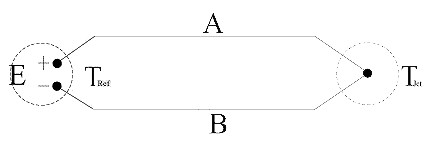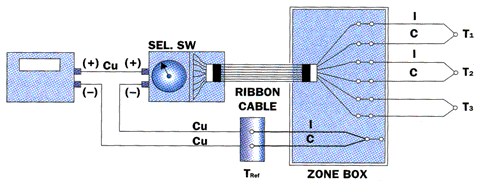Introduction
Thermocouples are the most widely used temperature sensor in test anddevelopment work. Accurate temperature measurements can be made at low costwith shop-built probes and ordinary low-level voltmeters.
What Are Thermocouples and How Do They Work?
Any two wires of different materials can be used as a thermocouple ifconnected together as in Figure 1. The AB connection is called the “junction”. When the junction temperature, TJct, is different from thereference temperature, TRef, a low-level DC voltage, E , will beavailable at the +/- terminals. The value of E depends on the materials A andB, on the reference temperature, and on the junction temperature. The governingequations for two-wire thermocouples are shown in Eq. 1 through to Eq. 4. If acircuit has more than two wires, more terms would be needed.
 Fig. 1 The simplest thermocouple
Fig. 1 The simplest thermocouple
From Eq. 1, we can see that the EMF is generated by the wires, not thejunction: the junction being just an electrical connection between the twowires. The signal is generated in the wires where the temperature gradient,dt/dx, is not zero: uniform temperature wires do not generate any EMF. If bothwires are uniform in calibration, then Eq. 2 can be used, and if the two wiresboth begin at TRef and end at TJct, then Eq. 3 applies. EMF-Temperature tables can only be used when the circuit consists of only twowires, both of which are uniform in calibration, and both of which begin at TRefand end at TJct. When only small temperature differences areinvolved, the values of Aand
B can be treated asconstants, and Eq. 4 gives a good approximation to the EMF.
Thermocouple Materials
The three most common thermocouple alloys for moderate temperatures areIron-Constantan (Type J), Copper-Constantan (Type T), and Chromel-Alumel (TypeK).
- The first named element of the pair is the positive element.
- The negative wire is color coded red (current U.S. standards).
Three grades of wire are available in each type, based on calibrationaccuracy: Precision, Standard, and Lead-Wire. The calibration of PrecisionGrade thermocouple wire is guaranteed within +/- 3.8% or 1°C(2°F),which ever is the larger, while Standard grade is within +/- 3.4% or 2°C (4°F),and Lead-Wire grade within +/- 1%. The accuracy statement can be interpreted asthe percent of the difference between the TJct and TRef. Considering the low cost of even the best material, it is hard to justify thepurchase of any but Precision Grade material, even for extension wire.
All three types (J, K, and T) are available as insulated duplexed pairs from0.001-inch diameter on up. For accuracy, and minimum system disturbance, thesmaller the wire the better, but wire smaller than 0.003-inch diameter is veryfragile.
Iron-Constantan: Iron-Constantan (Type J, color coded white and red)generates about 50 µV/°C (28 µV/°F). The Iron wire ismagnetic. Junctions can be made by welding or soldering, using commonlyavailable solders and fluxes.
Iron-Constantan thermocouples can generate a galvanic EMF between the twowires and should not be used in applications where they might get wet.
Chromel Alumel: Chromel-Alumel (Type K, color coded yellow and red)generates about 40 µV/°C (22 µV/°F). The Alumel wire ismagnetic. Junctions can be made by welding or soldering, but high temperaturesilver-solders and special fluxes must be used.
Chromel-Alumel thermocouples generate electrical signals, while the wiresare being bent, and should not be used on vibrating systems, unless strainrelief loops can be provided.
Copper-Constantan: Copper-Constantan (Type T, color coded blue andred) generates about 40 µV/°C (22 µV/°F). Neither wire ismagnetic. Junctions can be made by welding or soldering with commonly availablesolders and fluxes.
Copper-Constantan thermocouples are very susceptible to conduction error,due to the high thermal conductivity of the copper, and should not be usedunless long runs of wire (100 to 200 wire diameters) can be laid along anisotherm.
Thermocouple Probes
The simplest (and cheapest, and quickest) thermocouple probe is simply apair of wires twisted or crimped together at one end with the other endconnected to the terminals of a voltmeter. More often, however, probes areeither purchased or made in-house.
Purchasing Thermocouples: Thermocouples can be purchased from anumber of suppliers and, generally speaking, are readily available. There willbe times, however, when a new thermocouple is needed – now and not tomorrow —so every lab should be able to make simple thermocouples.
Shop-made Thermocouples: Most thermocouples needed for electronicscooling applications can be made in-house from bulk thermocouple wires bought asspools of insulated pairs. If a thermocouple welder, or any “fine-wire”welder is available, welding is generally quicker and easier than soldering. Any solder which wets both wires can be used to make the junction. Keep theweld bead or solder ball within 10 to 15% of the wire diameter. All otherfactors being the same, a thermocouple with a soldered junction is just asaccurate as one with a welded junction.
Reference Temperature Systems and Zone Boxes
The signal from a thermocouple depends as much on the reference junctiontemperature as it does on the measuring junction temperature. There are severaldifferent systems for establishing a reference temperature.
Ice Baths: Ice baths are widely used, because they are accurate andinexpensive. Any potable water freezes within about 0.01°C of zero. Adrug-store thermos flask will maintain 0°C for several hours if filled withfinely crushed ice, and then flooded with water.
Electronically Controlled References: Electronically controlledreference temperature devices are available, both high temperature andice-point. These devices require periodic calibration and generally are not asstable as ice-baths, but are more convenient.
Compensated Reference Temperature Systems: Dedicated temperatureindicators terminate each thermocouple at a connection panel inside the chassisand use a compensation network to inject a signal which compensates for thetemperature of the panel before calculating the temperature.
Zone Boxes: A zone box is a region of uniform temperature used toensure that all connections made within it are at the same temperature. Thetemperature need not be controlled, nor need it be measured — it need onlybe uniform. Circuits using zone boxes are shown in Figures 3 and 4.
A simple zone box can be made by gluing an electrician’s barrier strip tothe inside of a small, thick-walled Aluminum chassis box, closed to prevent aircirculation.
Measuring Instruments
There are two options:
- Use a reference temperature bath (an ice bath, for example) and a generalpurpose voltmeter, interpreting the signal using a table, by hand or usingsoftware.
- Use a dedicated temperature indicator with reference temperaturecompensation.
The reference-bath/voltmeter/table look-up system is more flexible,potentially more accurate, and can be used to measure temperature differences aswell as temperature levels. Dedicated temperature indicators are moreconvenient for routine measurements.
Circuits
An ideal thermocouple consists of a pair of unbroken, homogeneous wires ofdissimilar material, connected together at one end with the other end of thepair in a “reference temperature” region, as shown earlier in Figure1. As a practical matter, the signal must be brought out of the referencetemperature region to a voltmeter at room temperature. This is done using apair of copper wires (from the same spool) as shown in Figure 2.

The following figures illustrate more complex circuits incorporatingswitches, connectors, and reference baths for single and multiple thermocouples. Measurements made using these circuits will be just as accurate as thosemeasurements obtained if each thermocouple had been “hard-wired” toits own reference bath and voltmeter.
Connectors: Figure 3 shows a circuit using extension wires and aconnector, instead of unbroken lengths of wire. The connector can be either athermocouple grade connector, or a barrier strip inside a zone box. If theextension wires are from the same spool of wire as the probe, this circuit isexactly equivalent to the ideal circuit.

Multiple Thermocouples: Figure 4 shows a circuit for reading anumber of thermocouples (three shown) using a voltmeter, a uniform-temperaturezone box, a double-pole selector switch (also uniform in temperature), and areference temperature bath. Multiple-conductor ribbon cable and “press-on”connectors can be used between the zone box and the selector switch. Theconnectors at the two ends of the ribbon cable must each be inside a zone-boxbut the two boxes need not be at the same temperature.

Both the zone box and the selector switch box must be kept isothermal; theyshould both be kept away from heat sources or direct sunlight etc.
Figure 5 shows another circuit for handling multiple thermocouples (threeare shown), in which each voltage is read separately, including the zone-boxtemperature signal. The zone-box signal must be added to the signal from eachchannel to get the total EMF, which should then be used to find the temperature.

The wiring should always be checked: the voltage on the referencethermocouple channel should be close to zero before the reference thermocoupleis put into the ice-bath, and should correspond to the zone-box temperatureafterwards.
If a dedicated multiple-channel temperature indicator is being used, theregion shown here as the zone box represents the thermocouple connection panelbuilt into the temperature indicator.
With a dedicated temperature indicator, the reference bath branch of thecircuit need not be used, since the internal electronics of the system willalways add a correction to the thermocouple signal based on the paneltemperature.
Measuring Differences: The temperature difference between two pointscan be directly measured by connecting the two negative wires together (at roomtemperature) and measuring between the two positive wires. The magnitude givesthe temperature difference, and the positive wire is connected to the hotter ofthe two locations. This approach offers no advantage in accuracy over readingthe two thermocouples separately and subtracting the temperatures. Figure 6shows a 4-wire circuit which yields very high precision in the measurement ofsmall temperature differences. One pair is used as a thermocouple to determinethe temperature level, and one pair is used to determine the temperaturedifference between two points.

The two copper extension wires should produce no EMF, regardless of thetemperature level. This can be confirmed by running the system initially with ashorting link across the two copper wires, inside the local zone box. The “localcalibration” (microvolts/degree at the measured temperature level) shouldbe used to interpret the difference voltage. Using precision grade wire, themeasurement is accurate to within +/- 3/8% of the difference, providing thetemperature in the local zone box is close to one of the two measured points.
Checking for Electrical Pick-up: A 4-wire thermocouple can be usedboth to measure temperature and to check for electrical pick-up. All four wiresare soldered together to form the measuring junction. Reading either pair as athermocouple yields the temperature of the junction. Reading across either pairof similar wires checks for electrical pick-up: two similar wires can notgenerate a thermoelectric signal so, if there is a voltage across the two Ironwires that is clear evidence of electrical noise.
Measuring Surface Temperature
There are three main problems in surface temperature measurement: (1)deciding what needs to be known about the surface temperature, (2) choosing arepresentative location to measure it, and (3) getting the thermocouple in goodthermal contact at the chosen location.
The two most frequently asked questions are:
(1) What is the maximum temperature?
(2) What is the average surface temperature?
Surface temperatures can vary widely on plastic encapsulated components. Thehot-spot may be small, only 1/4-inch in diameter, and sharply peaked, and themeasured temperature will depend sharply on the thermocouple location. The bestpractice would be to use a visualizing technique first (liquid crystal, orinfra-red) and then put the thermocouple on the hot spot.
To ensure an accurate surface temperature measurement, a length equal toabout the diameter of approximately 20 wires (including the insulation) must beglued down along an isotherm using thermally conductive cement. For a pointmeasurement, wrap that length into a tight, flat spiral coil. Alternatively,solder the junction to a piece of copper bus-bar tape (3M Company), perhaps 1/16inch square, and glue that to the surface.
Always use the smallest wire that can be handled without too much breakage.
Measuring Gas Temperature
There are three main problems in air temperature measurement:
(1) deciding what you want to know about the air temperature,
(2) choosing a representative location to measure it, and (3) breaking thethermal connection between the thermocouple junction and the hardware thatsupports it.
Cooling air temperature varies widely across a flow passage especially nearheated surfaces. The most common questions are:
(1) What is the average temperature? and, (2) What is the effectivetemperature of the coolant at this location?
The average temperature (the bulk mean temperature) is a fictitioustemperature, defined in terms of the total thermal energy carried by the flow.There is no good location for measuring it. The only practical approach is toestimate the flow rate and heat release and calculate the average temperature.
The effective temperature of the coolant is the temperature that anisolated, passive component would achieve: the adiabatic temperature of thecomponent, in a thermodynamic sense. For a passage heated mainly from one side,the effective temperature of the coolant at the heated wall is alwayshigher than the average, due to temperature stratification in the coolant.
A thermocouple slightly upstream of a component, and slightly above its topsurface will probably read close to the effective temperature, for thatcomponent. The effective temperature is different for each componentsince it depends on the streamlines striking it.
When measuring air temperature, isolate the thermocouple junction from thehardware that supports it. Generally speaking, about 20 diameters must beexposed to the flow between the junction and the point of attachment. Installthe junction “looking upstream” with the wires trailing downstreamalong the flow.
The smallest wire that can be handled without breakage should be used.







